In Development this week (Vol. 140, Issue 19)
Posted by Seema Grewal, on 17 September 2013
Here are the highlights from the new issue of Development:
Roadmap for human trophoblast model
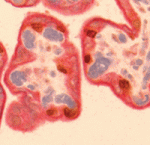 Correct trophoblast development is essential for placenta function and embryogenesis. In humans, the early stages of this process can only be modelled in vitro using embryonic stem cells (ESCs); however, owing to the failure to identify the stepwise progression that occurs during differentiation, the identity of the resulting cells is not clear. Now, on p. 3965, Mana Parast and colleagues narrow this gap by directly comparing various stages of in vitro trophoblast differentiation with in vivo cell types in the human placenta. The authors find that in vitro BMP4-driven trophoblast differentiation progresses through a p63+/KRT7+ stage that is akin to cytotrophoblast (CTB) cells in vivo. The CTB cells are the precursors of the terminally differentiated syncytiotrophoblast (STB) and extravillous trophoblast (EVT) cells. As expected, ESC-derived CTB-like cells can be differentiated further into functionally mature KLF4+ STB and HLA-G+ EVT cells. The authors propose that BMP4-driven differentiation of human ESCs is an accurate and informative model of human trophoblast development.
Correct trophoblast development is essential for placenta function and embryogenesis. In humans, the early stages of this process can only be modelled in vitro using embryonic stem cells (ESCs); however, owing to the failure to identify the stepwise progression that occurs during differentiation, the identity of the resulting cells is not clear. Now, on p. 3965, Mana Parast and colleagues narrow this gap by directly comparing various stages of in vitro trophoblast differentiation with in vivo cell types in the human placenta. The authors find that in vitro BMP4-driven trophoblast differentiation progresses through a p63+/KRT7+ stage that is akin to cytotrophoblast (CTB) cells in vivo. The CTB cells are the precursors of the terminally differentiated syncytiotrophoblast (STB) and extravillous trophoblast (EVT) cells. As expected, ESC-derived CTB-like cells can be differentiated further into functionally mature KLF4+ STB and HLA-G+ EVT cells. The authors propose that BMP4-driven differentiation of human ESCs is an accurate and informative model of human trophoblast development.
Plant germ cells count on chromatin
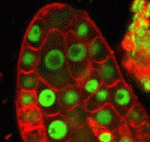 Unlike animals, plants do not set aside germ cells during embryogenesis. Instead, the precursors of these cells, called spore mother cells (SMCs), are generated via a somatic-to-reproductive transition that occurs later in life. Although epigenetic remodelling has been largely studied in the post-meiotic phase of germline development, it is unknown whether pre-meiotic events contribute to cellular reprogramming in the reproductive lineage. Now, on p. 4008, Célia Baroux and colleagues investigate these dynamic changes and uncover widespread chromatin reprogramming during the slow meiotic S-phase that accompanies specification of the female Arabidopsis SMC. As in animal primordial germ cells, the authors observe increased nuclear size, reduction in heterochromatin, depletion of linker histones, chromatin decondensation, changes in histone modifications and core histone variants in the female SMCs. The authors propose a bi-phasic chromatin reprogramming process that is necessary for proper somatic-to-reproductive cell fate transition and thus competency to establish the pluripotent, female gametophyte.
Unlike animals, plants do not set aside germ cells during embryogenesis. Instead, the precursors of these cells, called spore mother cells (SMCs), are generated via a somatic-to-reproductive transition that occurs later in life. Although epigenetic remodelling has been largely studied in the post-meiotic phase of germline development, it is unknown whether pre-meiotic events contribute to cellular reprogramming in the reproductive lineage. Now, on p. 4008, Célia Baroux and colleagues investigate these dynamic changes and uncover widespread chromatin reprogramming during the slow meiotic S-phase that accompanies specification of the female Arabidopsis SMC. As in animal primordial germ cells, the authors observe increased nuclear size, reduction in heterochromatin, depletion of linker histones, chromatin decondensation, changes in histone modifications and core histone variants in the female SMCs. The authors propose a bi-phasic chromatin reprogramming process that is necessary for proper somatic-to-reproductive cell fate transition and thus competency to establish the pluripotent, female gametophyte.
Vascular remodelling goes with the flow
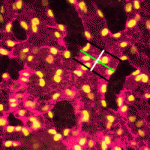 Mechanical forces such as blood flow play a key role in regulating vascular remodelling and angiogenesis. Vessel diameter must be tightly controlled to establish correct hierarchical vascular architecture, but how this is achieved is unclear. Now, on p. 4041, Mary Dickinson and colleagues report that vessel diameter in the mouse embryonic yolk sac is regulated by blood flow via two distinct mechanisms: vessel fusion and endothelial cell migration. Using live confocal imaging of dual Flk1-reporting whole embryos, the authors observe that vessel fusion only occurs in areas of relatively high flow, and that this leads to a rapid increase in vessel diameter. In addition, high flow also facilitates the preferential recruitment of endothelial cells from smaller capillaries, which further increases vessel diameter. Analyses using the Mlc2a mutant, in which blood flow is compromised, supports these findings. This study highlights the importance of mechanical forces in regulating individual cell behaviour as well as more complex processes such as the establishment of correct vascular architecture.
Mechanical forces such as blood flow play a key role in regulating vascular remodelling and angiogenesis. Vessel diameter must be tightly controlled to establish correct hierarchical vascular architecture, but how this is achieved is unclear. Now, on p. 4041, Mary Dickinson and colleagues report that vessel diameter in the mouse embryonic yolk sac is regulated by blood flow via two distinct mechanisms: vessel fusion and endothelial cell migration. Using live confocal imaging of dual Flk1-reporting whole embryos, the authors observe that vessel fusion only occurs in areas of relatively high flow, and that this leads to a rapid increase in vessel diameter. In addition, high flow also facilitates the preferential recruitment of endothelial cells from smaller capillaries, which further increases vessel diameter. Analyses using the Mlc2a mutant, in which blood flow is compromised, supports these findings. This study highlights the importance of mechanical forces in regulating individual cell behaviour as well as more complex processes such as the establishment of correct vascular architecture.
Mechanical forces fly high in wing morphogenesis
Mechanical forces regulate cellular behaviour to guide correct tissue size and shape. Distribution of stress can affect individual cell morphology, but how global forces are balanced across the whole tissue is largely unknown. In this issue, two papers examine how mechanical stress influences cell shape, and how these forces converge to regulate tissue morphogenesis in the developing Drosophila wing.
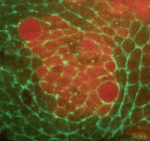 On p. 4051, Thomas Lecuit and colleagues investigate the global pattern of stress in the developing wing disc. They find that cell shape is governed by stretching at the periphery and compression at the interior, which may arise from increased proliferation at the centre of the wing. Cells at the periphery counteract this stress by polarising Myosin II tangent to the wing pouch, and by switching their cell division axis to align with the direction of stress. To support these findings, the authors inactivate Hippo signalling to mimic the effect of overproliferation. They observe a loss of the directionally dependent stress effect and a reduced apical surface in the mutant clones compared with their wild-type counterparts, which results in distortion of the bordering cells. These results suggest that the pressure exerted by proliferating cells influences global mechanical stress, which in turn regulates tissue morphogenesis at the periphery of the wing.
On p. 4051, Thomas Lecuit and colleagues investigate the global pattern of stress in the developing wing disc. They find that cell shape is governed by stretching at the periphery and compression at the interior, which may arise from increased proliferation at the centre of the wing. Cells at the periphery counteract this stress by polarising Myosin II tangent to the wing pouch, and by switching their cell division axis to align with the direction of stress. To support these findings, the authors inactivate Hippo signalling to mimic the effect of overproliferation. They observe a loss of the directionally dependent stress effect and a reduced apical surface in the mutant clones compared with their wild-type counterparts, which results in distortion of the bordering cells. These results suggest that the pressure exerted by proliferating cells influences global mechanical stress, which in turn regulates tissue morphogenesis at the periphery of the wing.
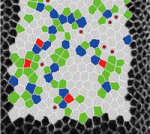 The role of mechanical stress in regulating cell shape and tissue morphogenesis is further examined by Shuji Ishihara and Kaoru Sugimura (p. 4091), who investigate the formation of hexagonal cell geometry in the phase II pupal wing. The authors use live imaging and Bayesian inference to map global mechanical forces in response to defined perturbations. They show that the direction of stress originates primarily from the attachment site to the wing hinge, and that this results in a redistribution of myosin, which enables greater tension at the cell junction as a means to resist tissue stretch. This in turn provides directional information for the cells, which ultimately results in the hexagonal configuration and a structurally balanced wing.
The role of mechanical stress in regulating cell shape and tissue morphogenesis is further examined by Shuji Ishihara and Kaoru Sugimura (p. 4091), who investigate the formation of hexagonal cell geometry in the phase II pupal wing. The authors use live imaging and Bayesian inference to map global mechanical forces in response to defined perturbations. They show that the direction of stress originates primarily from the attachment site to the wing hinge, and that this results in a redistribution of myosin, which enables greater tension at the cell junction as a means to resist tissue stretch. This in turn provides directional information for the cells, which ultimately results in the hexagonal configuration and a structurally balanced wing.
Distinct SCL isoforms regulate HSC emergence
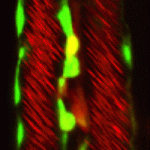 The emergence of haematopoietic stem cells (HSCs) from the aorta-gonad-mesenephros (AGM) region requires the coordinated activity of multiple transcriptional networks. The transcription factor stem cell leukemia (SCL) is necessary for this process; however, multiple scl isoforms exist and the exact stage at which each is required is unknown. In this issue (p. 3977), Zilong Wen and colleagues deconstruct the stage-specific requirement of scl isoforms scl-α and scl-β during the emergence of HSCs from the ventral wall of the dorsal aorta in zebrafish, which is equivalent to the AGM. Using dual fluorescent reporters coupled with in vivo time-lapse imaging, the authors show that scl-β is expressed in the haemogenic endothelial cells, whereas scl-α is expressed after the endothelial-to-haematopoietic transition has occurred. In loss-of-function studies, the authors show that scl–β is necessary for the specification of the haemogenic endothelial cells, whereas scl-α acts to maintain the newly born HSCs. This study represents an important step in teasing apart the transcriptional complexity that governs HSC development.
The emergence of haematopoietic stem cells (HSCs) from the aorta-gonad-mesenephros (AGM) region requires the coordinated activity of multiple transcriptional networks. The transcription factor stem cell leukemia (SCL) is necessary for this process; however, multiple scl isoforms exist and the exact stage at which each is required is unknown. In this issue (p. 3977), Zilong Wen and colleagues deconstruct the stage-specific requirement of scl isoforms scl-α and scl-β during the emergence of HSCs from the ventral wall of the dorsal aorta in zebrafish, which is equivalent to the AGM. Using dual fluorescent reporters coupled with in vivo time-lapse imaging, the authors show that scl-β is expressed in the haemogenic endothelial cells, whereas scl-α is expressed after the endothelial-to-haematopoietic transition has occurred. In loss-of-function studies, the authors show that scl–β is necessary for the specification of the haemogenic endothelial cells, whereas scl-α acts to maintain the newly born HSCs. This study represents an important step in teasing apart the transcriptional complexity that governs HSC development.
PLUS:
The developmental origins of adipose tissue
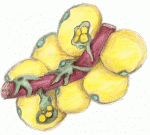 The formation and maintenance of adipose tissue is essential to many biological processes and when perturbed leads to significant diseases. Here, Jon Graff and colleagues highlight recent efforts to unveil adipose developmental cues, adipose stem cell biology and the regulators of adipose tissue homeostasis and dynamism. See the Review on p. 3939
The formation and maintenance of adipose tissue is essential to many biological processes and when perturbed leads to significant diseases. Here, Jon Graff and colleagues highlight recent efforts to unveil adipose developmental cues, adipose stem cell biology and the regulators of adipose tissue homeostasis and dynamism. See the Review on p. 3939
The regulation of Hox gene expression during animal development
 Hox genes encode a family of transcriptional regulators that elicit distinct developmental programmes along the head-to-tail axis of animals. Here, Mallo and Alonso examine the spectrum of molecular mechanisms that control Hox gene expression in model vertebrates and invertebrates. See the Review article on p. 3951
Hox genes encode a family of transcriptional regulators that elicit distinct developmental programmes along the head-to-tail axis of animals. Here, Mallo and Alonso examine the spectrum of molecular mechanisms that control Hox gene expression in model vertebrates and invertebrates. See the Review article on p. 3951
Developing insights into cardiac regeneration
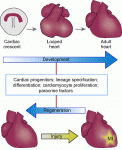 The recent EMBO/EMBL-sponsored symposium ‘Cardiac Biology: From Development to Regeneration’ gathered cardiovascular scientists from across the globe to discuss the latest advances in our understanding of the development and growth of the heart, and application of these advances to improving the limited innate regenerative capacity of the mammalian heart. Christoffels and Pu summarize some of the exciting results and themes that emerged from the meeting. See the Meeting Review on p. 3933
The recent EMBO/EMBL-sponsored symposium ‘Cardiac Biology: From Development to Regeneration’ gathered cardiovascular scientists from across the globe to discuss the latest advances in our understanding of the development and growth of the heart, and application of these advances to improving the limited innate regenerative capacity of the mammalian heart. Christoffels and Pu summarize some of the exciting results and themes that emerged from the meeting. See the Meeting Review on p. 3933


 (No Ratings Yet)
(No Ratings Yet)